Best Things to Do in San Marino (and Why You’ll Want to Stay for Sunset)
San Marino is the third smallest country in Europe and proudly calls itself the world’s oldest surviving republic. Perched high on Mount Titano, it’s a maze of steep medieval lanes, arched gateways and stone terraces with sweeping views across Italy. And those views are some of the best you’ll find anywhere in Europe. Read on and I’ll share with you the best things to do in San Marino plus tips to make the most of your time in this remarkable microstate.
Visited in June 2024, all information reviewed and updated in October 2025
Planning a Trip to San Marino? Here’s where You’ll Find Things
This guide may include a few affiliate links. If you choose to buy something through one of them, I may earn a small commission (at no cost to you). Thank you for supporting One Small Bag and helping keep this resource ad-free and independent.
And here’s some more on the ‘Little Countries of Europe’ topic from One Small Bag blog if you’re interested:
Is San Marino Worth Visiting
Absolutely, San Marino is one of Europe’s most underrated destinations. Just a short, scenic bus ride from Rimini on Italy’s Adriatic coast, it offers an easy escape into another world. You can spend a blissful day wandering through cobbled streets, browsing quirky shops, and admiring views that stretch for miles in every direction. For the full experience, stay overnight and catch the spectacular sunset over Mount Titano and you’ll be rewarded with a peaceful, lantern lit magic few visitors ever see.

Where to Stay in San Marino
There are broadly two potential options here. You could stay within the old town for the views and atmosphere, or, as we did, at the base of the cable car for easier parking and access. For the widest range of accommodation options in San Marino, I’ve added an interactive map below.
Our stay at Hostaria da Lino, in Borgo Maggiore was perfect. A traditional hotel and restaurant with friendly staff, exceptional food, and a proper local feel. It made an easy base for heading up to the old city via the cable car, just a few yards from the front door. The only small drawback – the cable car stops running after sunset, so we had to walk down a path after dark from the old city to get back to the hotel. We didn’t mind, but I mention it, because some might.
Best Things To Do In San Marino
Whether you arrive by bus from Rimini, by car, or via the cable car from Borgo Maggiore, you’ll find San Marino wonderfully compact and best explored on foot. Most of the main sights lie within the city walls. The Three Towers are the one exception. They’re spread along the ridge of Mount Titano and reached by a hilly walk.

I’ve marked the key points on my Map of Things to Do in San Marino.
Wander The City Streets
Wandering through the picturesque city streets of San Marino is delightful. You’ll encounter stunning views as you stroll past historic buildings and charming shops. Make sure to visit the main piazzas and soak in the atmosphere.
Let’s start right in the centre.
Piazza della libertà and Palazzo Pubblico
In the middle of the old city, Piazza della Libertà is classic San Marino. The stone arches, flag-topped views and striking Palazzo Pubblico, are instantly recognisable. Inside the Palazzo Pubblico, you can see the heart of San Marino’s government, including the chambers of the San Marino Councils and the offices of the Captains Regent. Entry is by ticket, and opening hours are usually 9 am to 5 pm, though they may vary. Or simply visit at golden hour for the best photos.
Palazzo Pubblico with Statue of Liberty in front at sunset Street Performers on the ledge overlooking the view Palazza Pubblico
In front of the Palazzo Pubblico stands the Statue of Liberty, carved from white marble. It portrays Liberty as a warrior and it’s become one of the republic’s defining symbols. You’ll also find her on the country’s two-euro coin.
To experience a slice of San Marino’s history, don’t miss the changing of the guards ceremony. The guards appear every half an hour, during the afternoon in the summer months. Or instead, you could stumble across street performers, entertaining visitors, as we did.
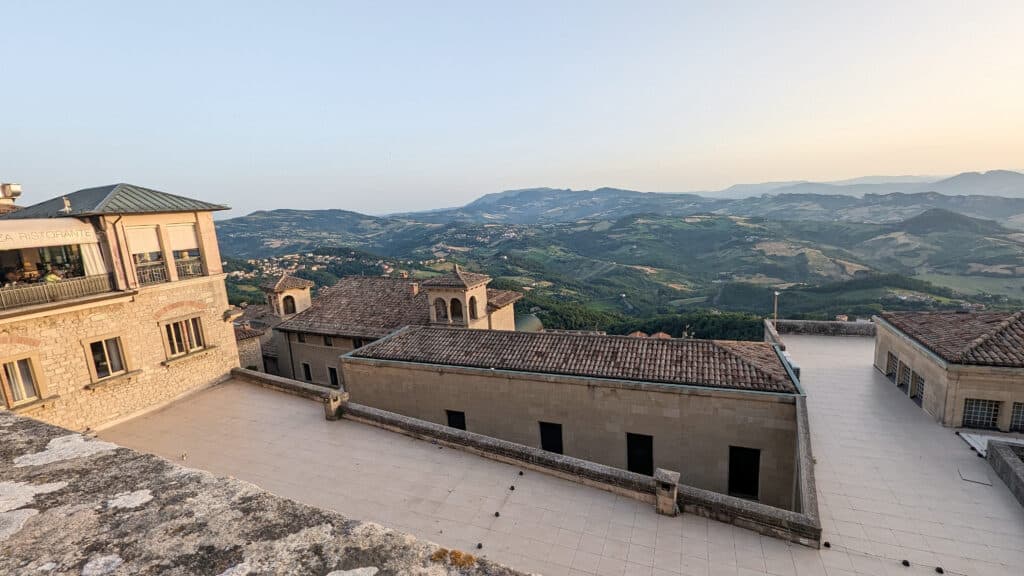
As we walked on, this was our first view of Chiesa di San Pietro, the small church next to the Basilica del Santo. and another sunset view.
Basilica del Santo and Chiesa di San Pietro
At the northern edge of the old town, the Basilica del Santo (Basilica di San Marino) is the spiritual heart of the republic. It houses the relics of Saint Marinus, the stonemason who founded San Marino in 301 AD. The neoclassical façade and grand Corinthian columns give it an almost Roman feel. Entry is free, and it’s worth stepping inside.

It’s also possible to visit Chiesa di San Pietro next door. It’s a tiny chapel carved partly into the rock.
Giardino Panoramico
Tucked just below the main streets, the Giardino Panoramico (Panoramic Garden) is one of San Marino’s quieter lookouts. The entrance, marked by its stone archway, leads to a small terraced garden with benches and wide-open views over the surrounding valleys. It’s free to enter and we had the place to ourselves.
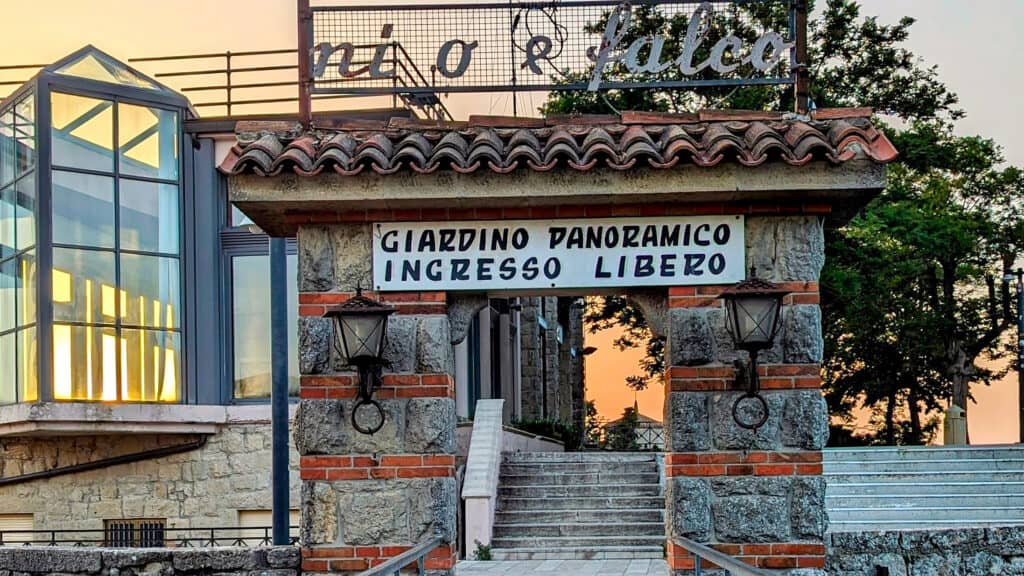
Piazza Sant’Agata
Make time for Piazza Sant’Agata, a broad terrace with one of the best panoramas in the city. The square is anchored by the statue of Saint Marinus. From here, the view stretches all the way to the Adriatic.
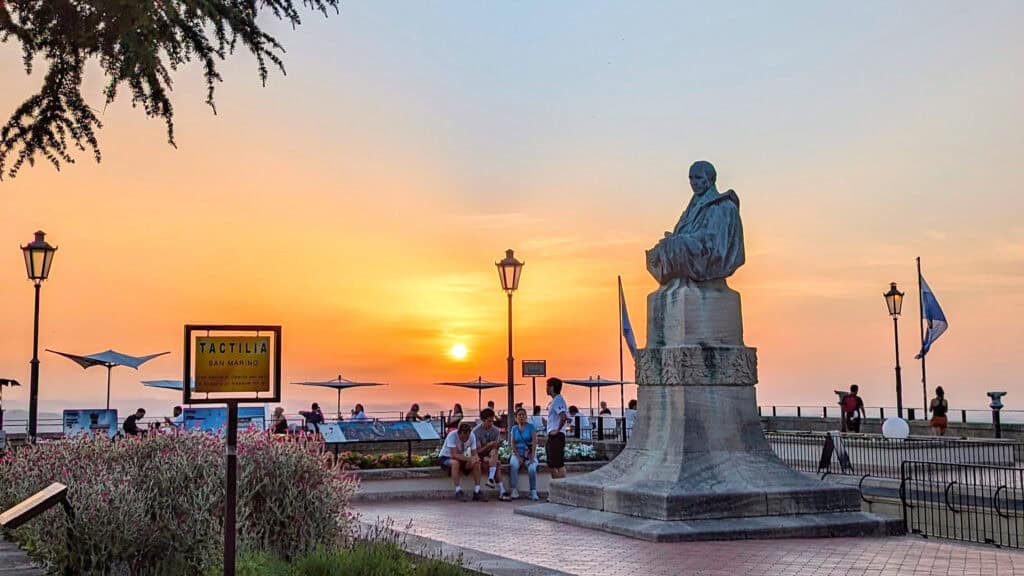
As the sun sets and the sky glows over the hills, it’s a beautiful place to pause, pinch yourself and reflect on the privilege of being here. A fitting finale to our first day in San Marino.
Shopping in San Marino
Shopping in San Marino is as much about atmosphere as buying anything, but if you do, the republic is duty-free, so you’ll see lower prices than in Italy.
La Saponeria del Titano – Artisan soap in San Marino Shopping streets of San Marino
The narrow cobbled alleys twist past little boutiques selling leather bags, ceramics, perfume, glassware, and replica gun and weapons shops. And yes, you read that right, San Marino’s shopping scene is as eclectic as its history!
Via Basilicius and Church of San Francesco
As you explore the narrow lanes between the city gates and the basilica, you’ll find quiet little streets and plenty of opportunities for photos.
Shops and cafés in the upper streets of San Marino’s old town Via Basilicius and Church of San Francesco
One of the prettiest is Via Basilicius, which leads down to the Church of San Francesco and its adjoining cloistered museum. The stone steps, shopfronts and hanging awnings look like they’ve stayed unchanged for decades.
Cava dei Balestrieri
If you time things right, you can watch medieval archery with cross-bows at Cava dei Balestrieri. The Federazione Balestrieri Sammarinesi put events on during certain weekends and public holidays.
The site itself is an open-air stone quarry carved into the side of Mount Titano, just below the city walls. It’s worth a look, even if there are no events on during your visit.
Climb the Three Towers
If you’re up for a little adventure, consider climbing the three iconic towers of San Marino. The Witches’ Path connects the towers. Allow at least two hours for the walk and photo stops.
We’d run out of steam when we arrived in San Marino, having walked around 6 miles in the morning exploring Rimini in the heat, before we caught the bus to San Marino. We skipped the walk, so I don’t have the San Marino ‘money shot’ of the tower from the path up to the top. But we still feel we captured the essence of San Marino and it was made all the more special for being there in the evening for sun down.
The climb begins near Porta della Fratta, where San Marino’s old city walls rise above the lower streets. Stone steps lead upward toward the first of San Marino’s Three Towers, with sweeping views across the surrounding hills.
If you’re walking the route yourself, start with Guaita, the first and most complete of the towers. From there, follow the scenic Witches’ Path to Cesta, home to the Museum of Ancient Arms and some of the best panoramic views. If you still have energy, continue on to Montale, the smallest and most remote of the three. Tickets are sold at the entrance to the first tower, with combined options available if you plan to visit more than one. My map of things to do in San Marino shows the towers and the path, to orientate you.
And here’s some more from One Small Bag blog if you’re interested:
- Toulouse and the Machines – A Guide to A Fascinating City with a Steampunk Twist
- Things to do in Carcassonne – Here’s what I did, what I skipped and what I wish I’d known
- Beyond Duty-Free Shopping – 21 Best Things to Do in Andorra
- Everything You Need to Know Before Visiting Liechtenstein
- Transnistria Day Trip from Chișinău – Worth It
Ride the Cable Car
The San Marino cable car links the lower town of Borgo Maggiore with the historic centre at the top of Mount Titano. The journey takes a few minutes and there’s fantastic views over the hills. If it’s clear, you’ll spot the Adriatic sea in the distance
Cable Car at the top
San MarinoView across the rolling hills of Emilia-Romagna to the Adriatic
from the cable car at San Marino
The cable car cabins are modern and the journey smooth and frequent. It cost €3 one way / €4.50 return (check latest rates and times)
Via Costa dell’Arnella – path between the Old City at the top of Mount Titano and Borgo Maggiore in San Marino Our Hotel – Hosteria Da Lino in Borgo Maggiore
in San Marino
When the cable car isn’t running (it closes around dusk), you can walk down Via Costa dell’Arnella instead. The path was lit, so it was safe to use in the dark. It saved us taking our life in our hands, walking along the twisty main road.
Visit a Museum
San Marino’s compact size hides an impressive number of museums. There’s serious state collections mixed in with oddball fun. I’ve marked the main museums and landmarks on my San Marino “Things to Do” map. An €8 multi-museum ticket, purchased at one of the participating museums, will cover the main state-run sites including the Palazzo Pubblico, Towers and Natural History museum in Borgo Maggiore plus these ones:
- State Museum (Palazzo Pergami Belluzzi) – national collection of ancient artefacts and old Sammarinese coins.
- St Francis Art Gallery – set in a serene 15th-century cloister near the old gate.
- Modern and Contemporary Art Gallery – collection includes 20th-century Italian artists like Guttuso and Cucchi.
- Museum of Stamps and Coins – San Marino’s beautifully designed stamps dating back to 1877.
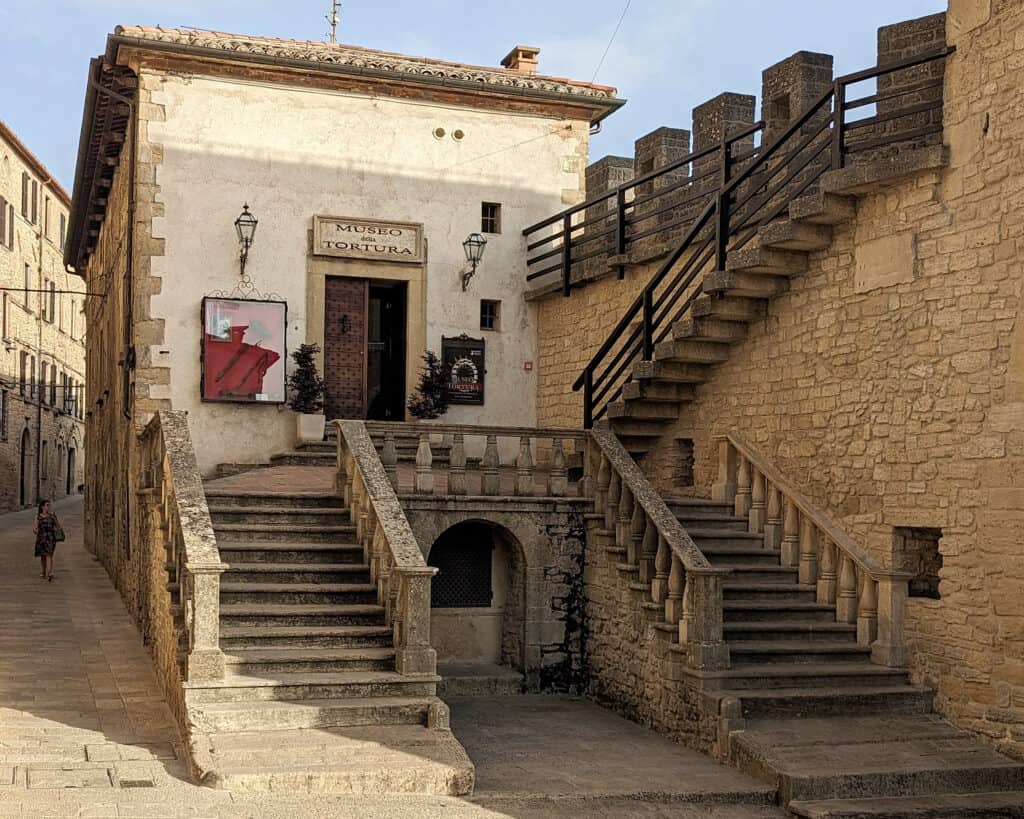
Beyond the official network, San Marino has a handful of private museums that cover the more eccentric end of the spectrum
- Museum of Curiosities – three floors of odd inventions, records and strange human feats.
- Wax Museum – small and retro with historical scenes from Garibaldi to Saint Marinus.
- Museum of Torture – from historical justice systems to modern human-rights awareness. Skip if you’re squeamish.
- Museum of Rural Culture (Casa Fabrica) – a time-capsule look at traditional Sammarinese life
- Titanus Museum -newer and interactive, using VR to tell the story of San Marino’s founding and independence.
- Museum of Vampires and Werewolves – the one to pick if you enjoy gothic myth and a touch of kitsch

We capitalised on the sunny weather and stayed outside, rather than visiting museums. San Marino’s charm lies as much in the atmosphere between its museums as in the collections themselves. Had we been unlucky with the weather, I’m sure we would have visited at least some of them.
Borgo Maggiore – San Marino Below the Mountain
If you have time, do explore Borgo Maggiore, the quiet town that sits directly beneath the old city. Once a traditional market settlement, it still feels like the practical heart of San Marino and full of local character. The main square, Piazza Grande, hosts a lively market on Fridays, and there’s a scattering of cafés and small shops around the cable car station, where locals gather.
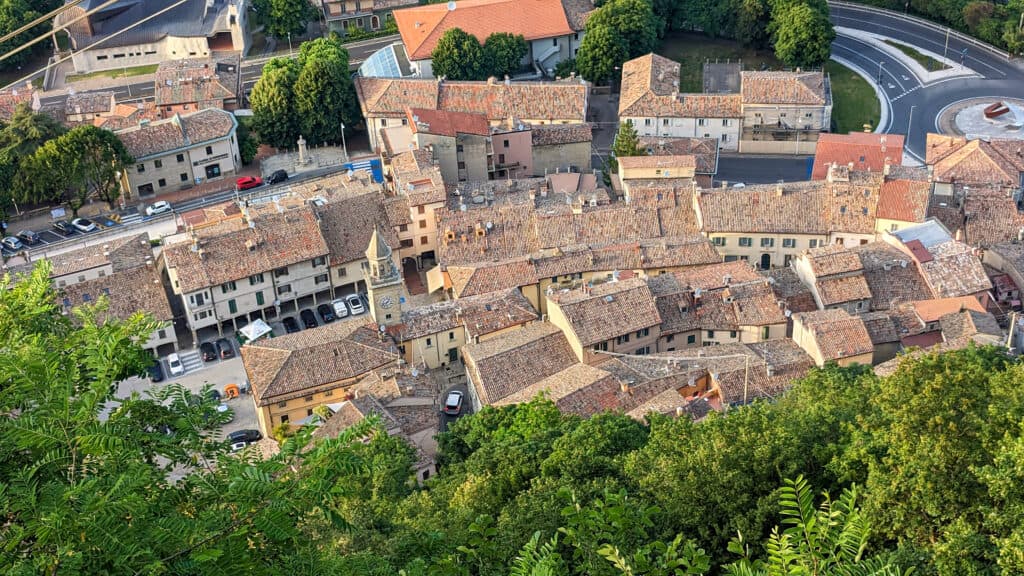
It’s also home to the Natural History Museum, which showcases the landscapes, flora and fauna of Mount Titano and the surrounding valleys. We stayed here in a friendly family-run inn right by the lower cable-car station, with an excellent restaurant and bar that’s popular with locals.
Map of Things To Do In San Marino
I’ve added all the places mentioned in this article on this map and also included the bus stop for the bus from Rimini, the road train stops (to take you between the old city and the bus stop, if you don’t want to walk), plus the cable car stations too.
Food and Drink In San Marino
Dinner at Hostaria da Lino in Borgo Maggiore was another highlight. Traditional northern Italian flavours enjoyed in a popular restaurant with a local clientele. Our delicious dishes included creamy courgette and pancetta risotto, fresh pesto ravioli with pine nuts, and a crisp spinach, walnut, and parmesan salad. The food felt far more local and relaxed than the pricier, tourist-oriented spots up in the old city.
Creamy Courgette and Pancetta Risotto Fresh Pesto Ravoli with Pine Nuts Crisp Spinach, Walnut and Parmesan Salad
And if you’re wondering what to look out for in San Marino, these dishes are popular:
Savoury Dishes to try in San Marino
- Pasta with truffle, porcini or pesto – simple, rich flavours that showcase local ingredients.
- Cappelletti in brodo – small stuffed pasta in a clear broth, especially good in cooler months.
- Polenta with sausage or game ragu – hearty mountain comfort food.
- Tagliata di manzo – grilled sliced steak, often topped with rosemary or parmesan.
Deserts and Sweets to try in San Marino
- Torta Tre Monti – San Marino’s signature layered wafer cake with chocolate and hazelnut cream.
- Bustrengo – a dense cake made with apples, raisins, and honey or polenta flour.
- Torta Titano – a lighter sponge with pastry cream and a hint of liqueur.
Drinks to try in San Marino
- San Marino DOC wines – especially Biancale (white) and Roncale (red).
- Local liqueurs – Tilus (truffle) and Fragolino (sweet wild strawberry).
- Italian coffee – taken properly, standing at the bar or savoured slowly with a view.
So food in San Marino is typically unfussy with rustic Italian simplicity. Best enjoyed, unrushed, with a glass of local wine.
Visiting San Marino – Your Questions Answered
Getting to San Marino by Public Transport
To get to San Marino by public transport, take a train to Rimini. From Rimini, catch a bus to San Marino. These operate regularly. The journey takes about 30 minutes. Check the Bonelli Bus website for stops and times of buses.
When Is The Best Time To Visit San Marino?
The best time to visit San Marino is from April to June and September to October, when the weather is mild and there are fewer tourists, but you can potentially visit all year.
How Long Should I Spend in San Marino
You can see the highlights in a day, but staying the night lets you experience the old city after the crowds leave and watch the sun set across the panoramic views of San Marino
Data & Roaming in San Marino
Treated as Italy for most mobile networks, but double-check your plan before you go.
Money Matters in San Marino
Similar to Italy. San Marino’s currency is the Euro. Most places take card, but holding some Euros in cash is always a good idea.
Immigration and Duty Free
San Marino isn’t in the EU or Schengen, but there are no border checks from Italy. If you want a San Marino stamp in your passport, you can get one at the San Marino Tourist Information Office. It’s not an official one, so if you don’t want to treat your passport as a scrap book, you could ask for it on a separate document.
You can buy duty free goods in San Marino
Language Spoken in San Marino
The local dialect is Sammarinese and is still in use, especially among the elderly population. The offcial language is standard Italian. English is also widely spoken, especially in places tourists visit.
If you’ve got this far and you’re intrigued by Europe’s other tiny countries, you might also enjoy my posts on Andorra and Liechtenstein. There’s also Pridnestrovian Moldavian Republic (PMR) – known as Transnistria, nestled between Moldova and Ukraine, as another take on the ‘tiny country’ theme.
I’ve more to post from Italy too, including Rimini and Bergamo. If you’d like monthly updates, I’d love it if you joined the newsletter.
Have you visited San Marino? Are you planning a visit to any of the other micronations? Do let me know in the comments.
Thanks for Reading. And still curious? Here’s some top posts from the One Small Bag blog.
-
Beyond Duty-Free Shopping – 21 Best Things to Do in Andorra
So yes, you can shop in Andorra, but there’s so much more! Here’s the things I found to do on…
-
Toulouse and the Machines – A Guide to A Fascinating City with a Steampunk Twist
Planning a trip to France’s Pink City? This guide to Toulouse Machines covers the city’s unique mechanical wonders alongside the must-see squares, churches, and day trips.
-
Visit the Painted Mosque in Tetovo From Skopje by Public Bus
In the foothills of the Šar Mountains, Tetovo’s Painted Mosque dazzles with colour — and it’s an easy bus ride from Skopje, making it one of the most rewarding day trips in North Macedonia
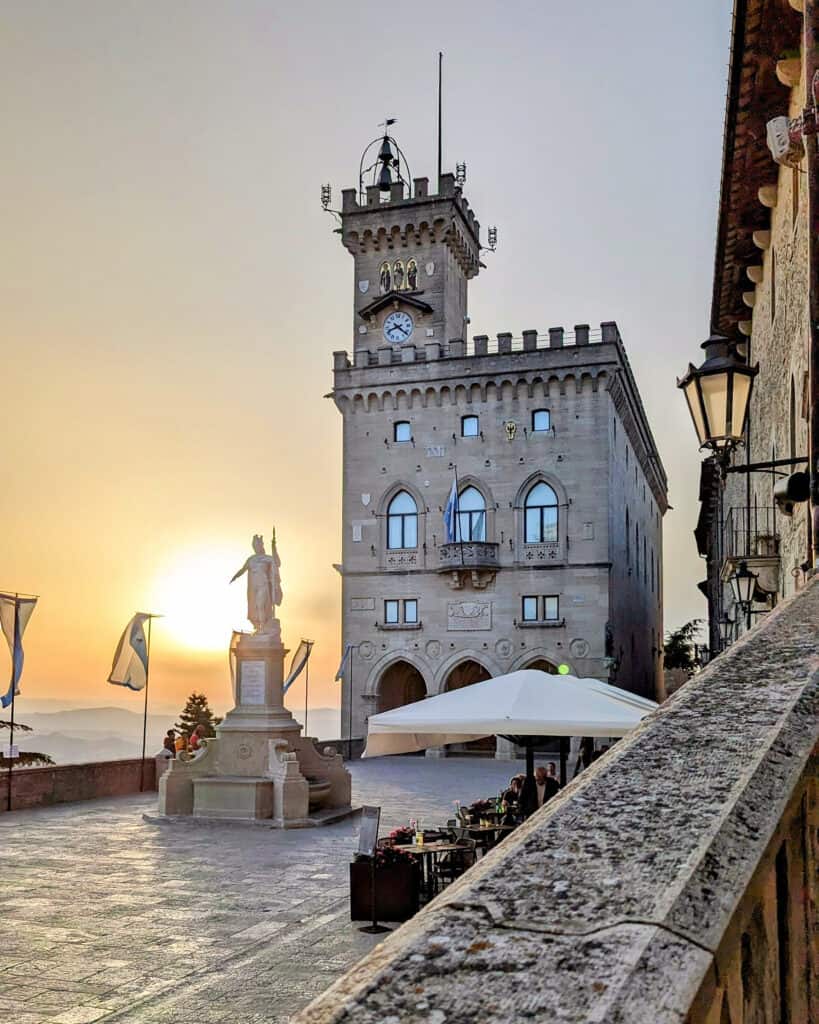




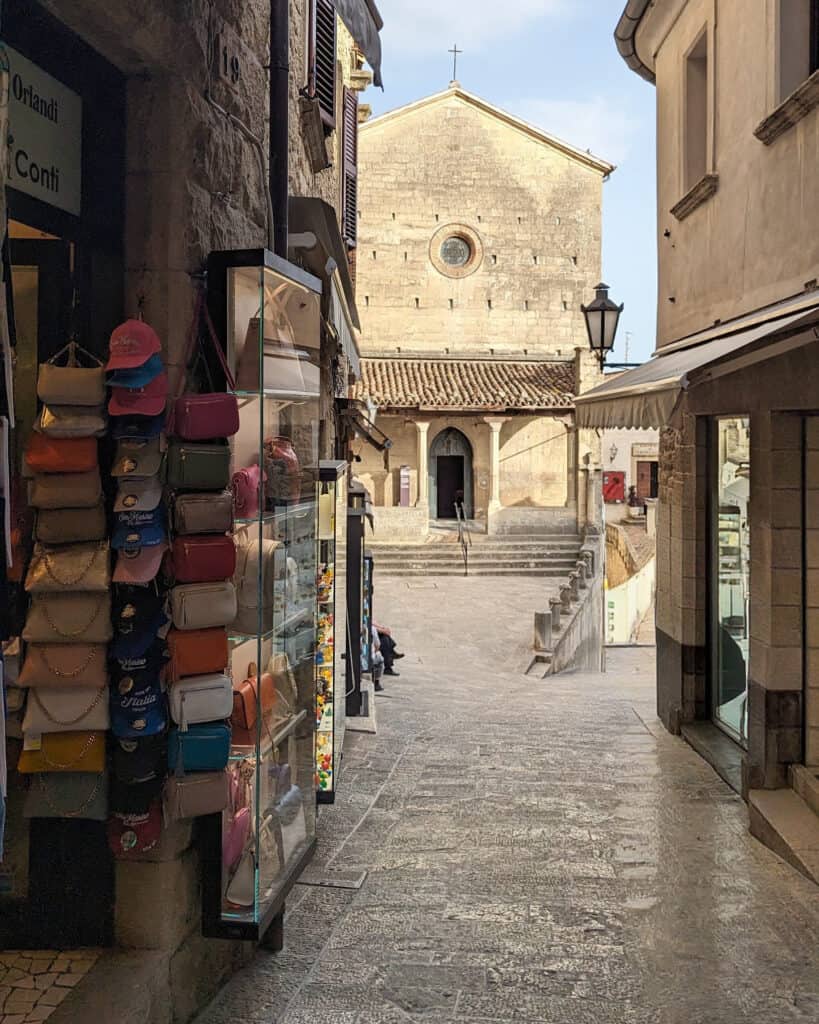
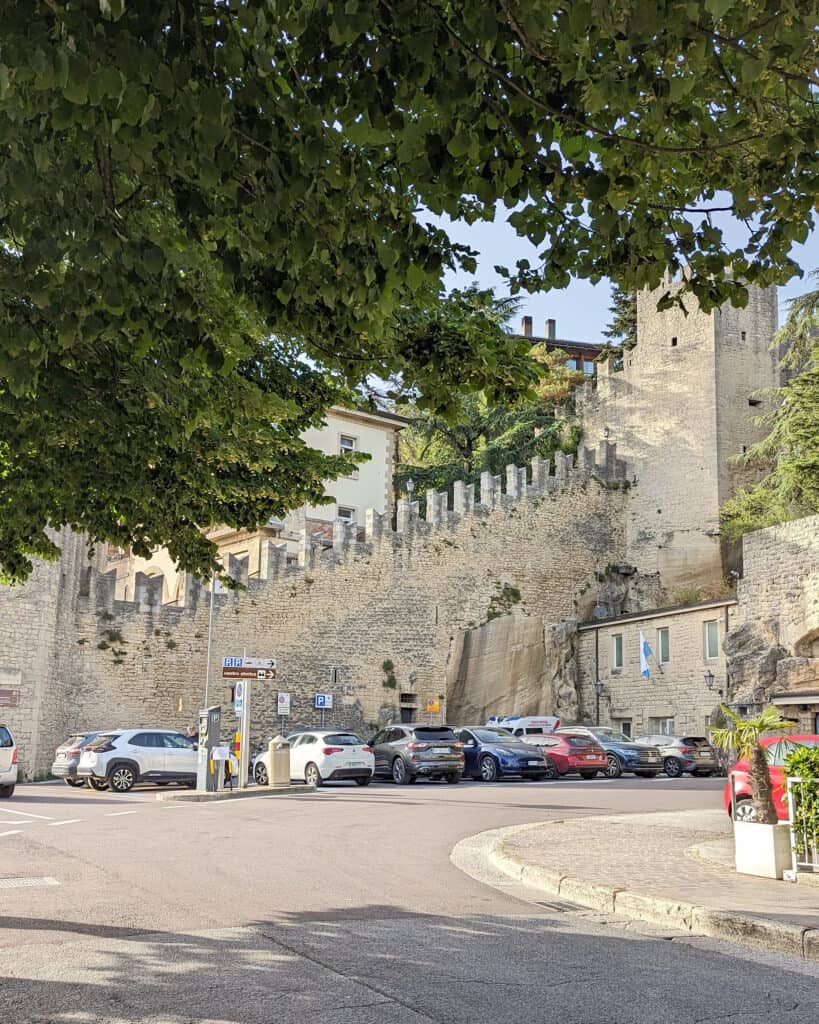
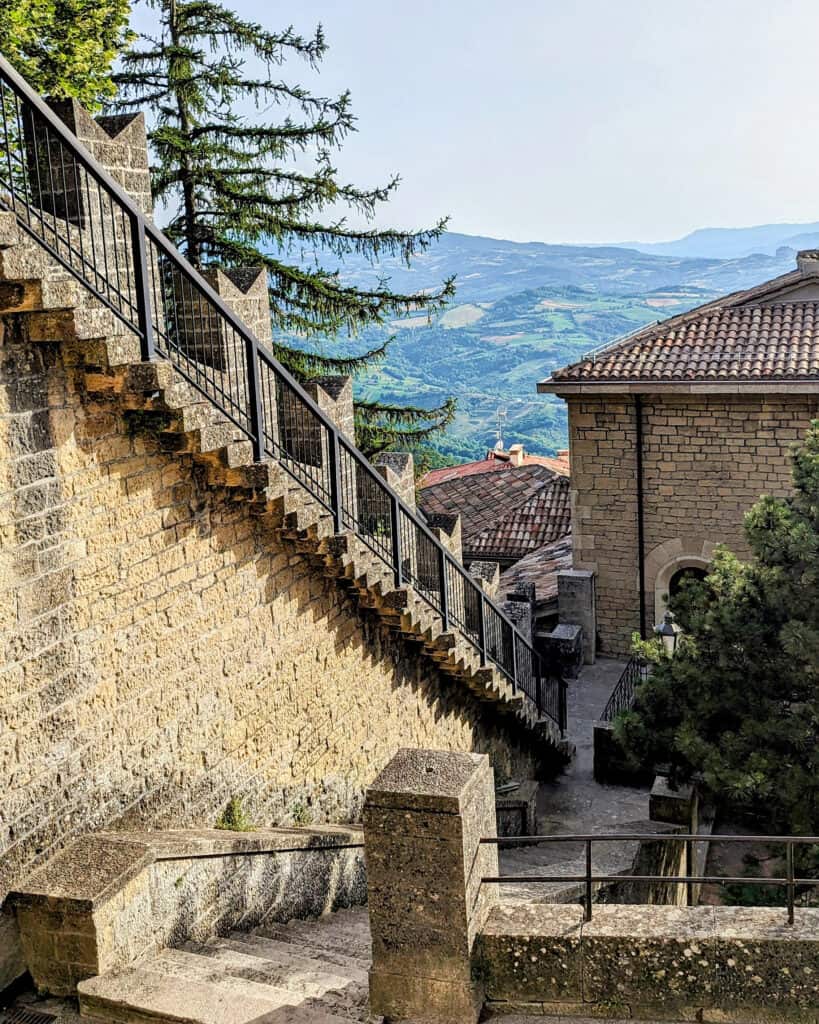


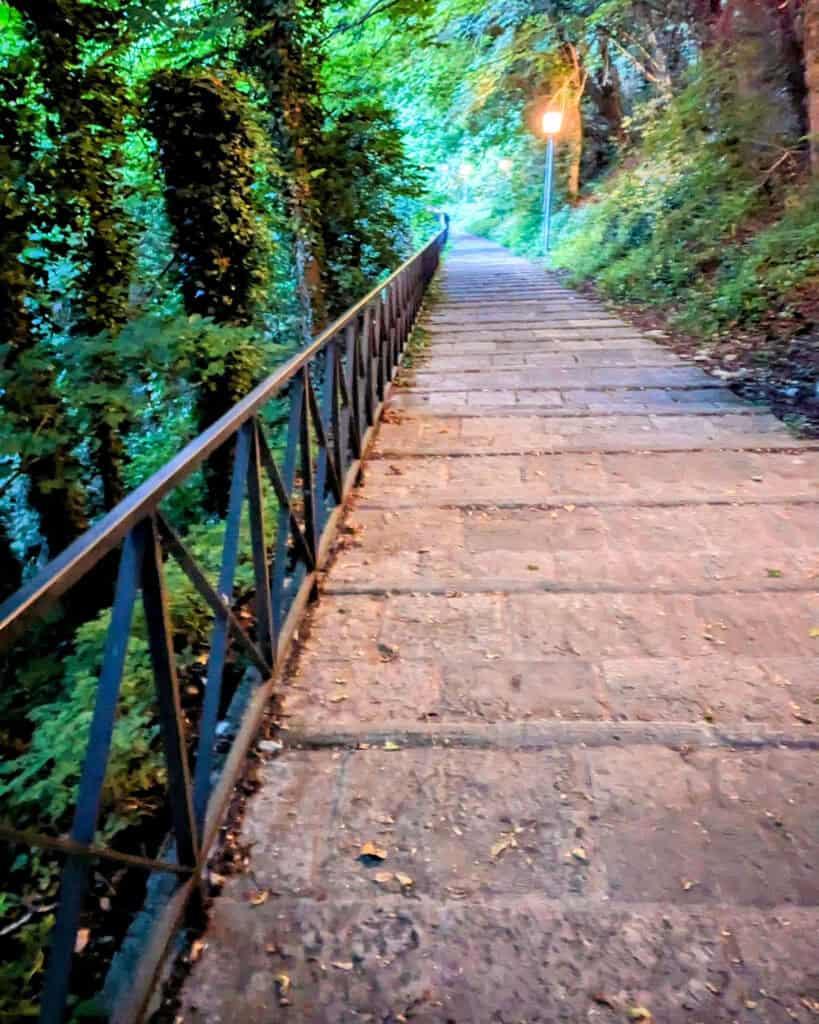


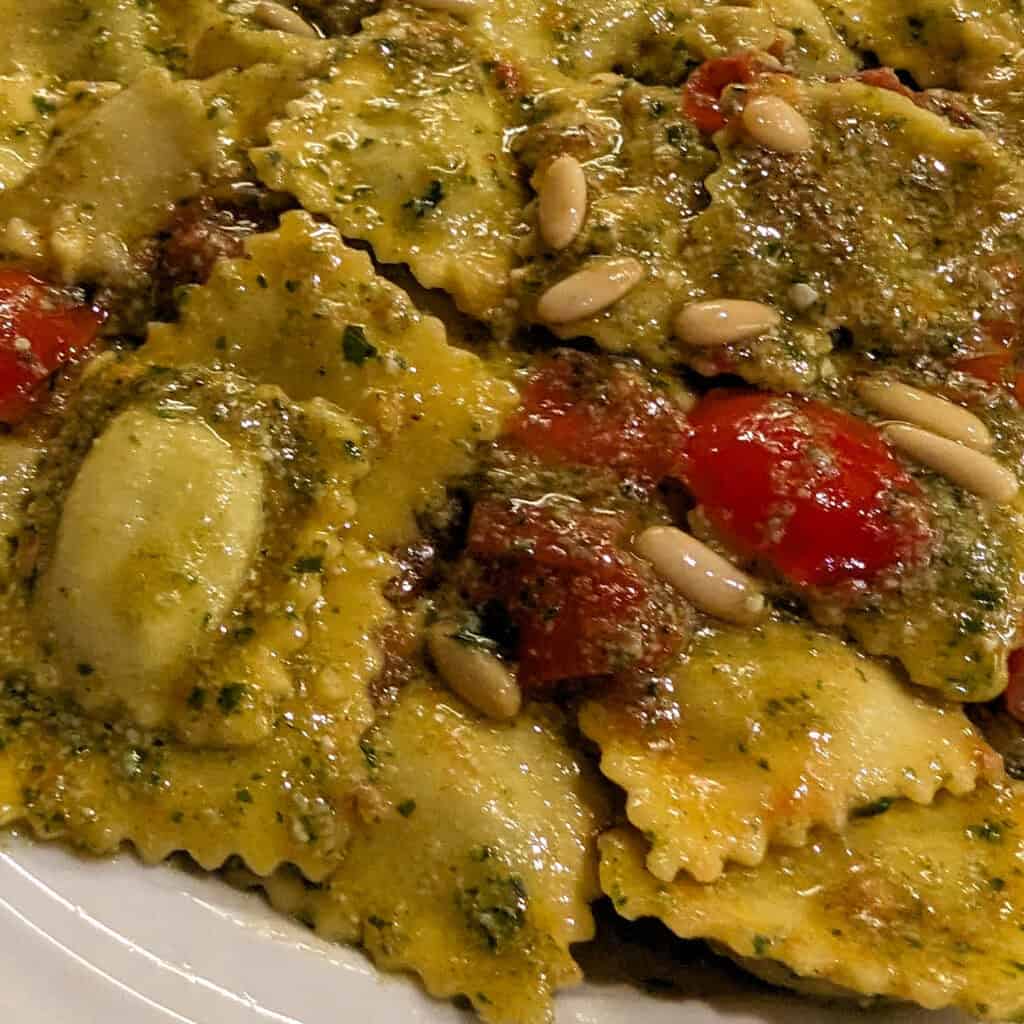
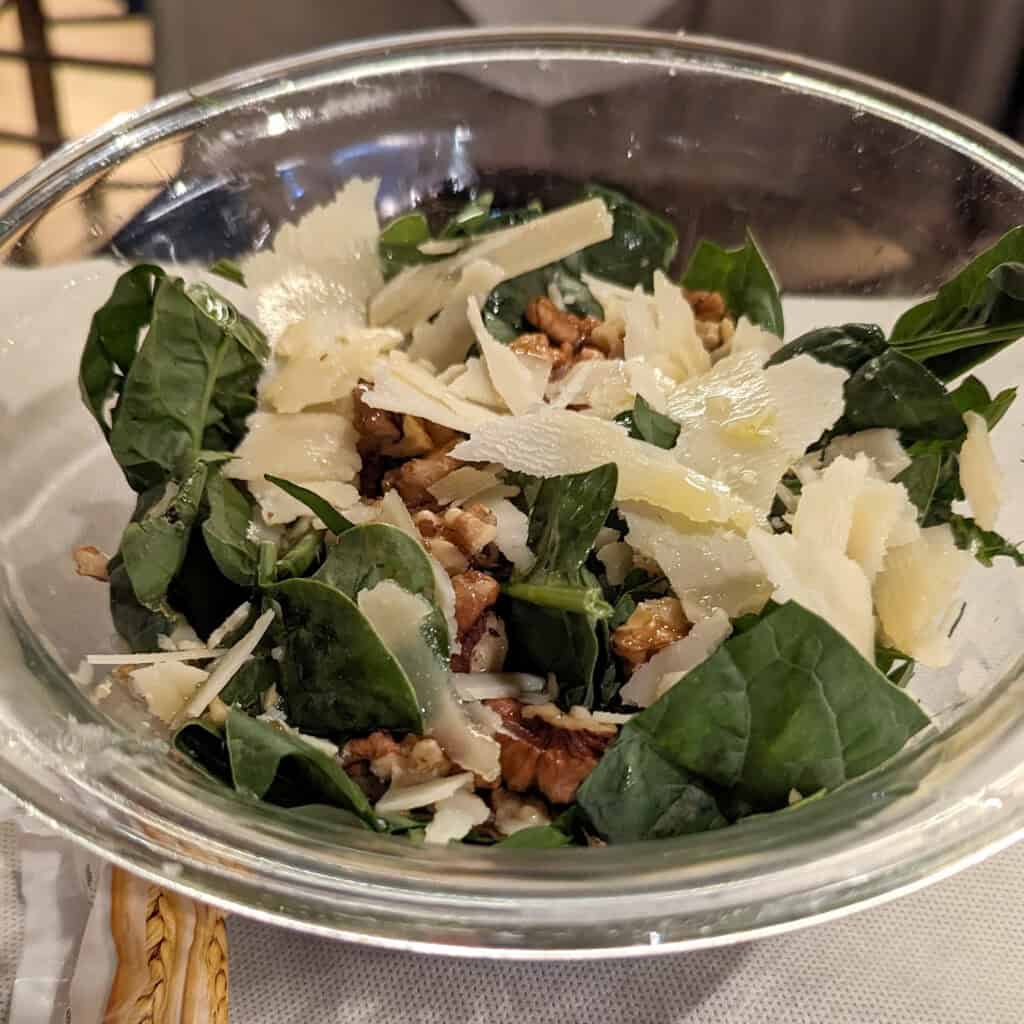
Great read.
The little bar attached to the lower cable car station is one of the best bars anywhere !